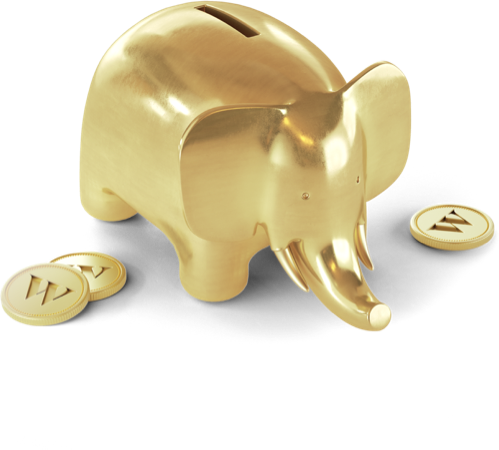Luisa Rollenhagen is a journalist and investor who writes about financial planning for Wealthsimple. She is a past winner of the David James Burrell Prize for journalistic achievement and her work has been published in GQ Magazine and BuzzFeed. Luisa earned her M.A. in Journalism at New York University and is now based in Berlin, Germany.
Wondering what a savings account is? We'll explain what they are, how savings accounts work, how to open one and calculate the interest you'll earn. We'll also let you in on something called high-yield savings accounts or a cash account, the ones with the potential to earn a lot more interest.
We’ll get to why taking your money and giving it to someone else isn’t, you know, a criminal activity!
Storing money in an account is a familiar enough idea, right? You do that in a checking account. And in a retirement account. And your wallet. (You see, there once was this wildly popular thing called “cash,” and it was often carried in a small…) The difference between a savings account and most other accounts is that your money earns interest while remaining extremely accessible to you.
A checking account, for instance, offers you instant access to your money for making purchases, but rarely generates any additional money (also known as interest) at all. On the other end of the spectrum, a RRSP is extremely inaccessible (in fact, you have to pay withholding taxes for early withdrawal) but the funds you’ve deposited in it have the potential to grow and grow.
A savings account splits the difference. It’s a place for you to save your money for use at a later date (a honeymoon or a down payment for a car, etc.) or as an emergency fund. Although, if a short-term need arises (the airline lost your luggage on the way to your honeymoon or your car broke down), you can immediately transfer some or all of your savings to a checking account to make a purchase and get out of a jam.
Our cash account doesn’t have an “introductory rate” — because introductory rates disappear. Get started with Wealthsimple to spend, save and earn 1.5% interest annually.How does a savings account work?
A savings account works by opening and funding your account. In return, the financial institution pays you interest on your savings because they use your money to make loans to other people.
That can be a hard idea to grasp: The bank is using my money for its own needs? After all, isn’t the whole point of savings to, you know, save my money? But the bank needs your money. That’s what banking is all about.
They take money from one person (and pay them interest) and loan money to other people (and charge them interest). The bank is always going to have enough money on hand that it can give you back what’s yours upon request. And, your money is protected. For example, with Wealthsimple Save your money is CIPF protected up to $1 million in the unlikely event that Wealthsimple becomes insolvent.
So, in the unlikely event, your institution fails or even if every account holder asked for their money back at the same time, you’ll get your money.
What is a high yield savings account?
A high yield savings account is a deposit account that offers higher interest rates to standard deposit accounts. The kind of financial institution you choose to save your money in has a significant effect on the interest rate you receive. Brick-and-mortar banks, which have all kinds of costs associated with building and running physical locations full of helpful people, tend to offer lower interest rates: generally less than 1%. And often way less. As in 0.03%.
Online financial institutions have relatively few overhead costs and can pass those savings on to you in the form of higher interest rates. You can find high-yield savings accounts online that pay much more than standard deposit accounts. A savings account interest rate which is usually expressed as “APY” or “annual percentage yield” is always going to be relatively modest, but the gap between online rates and brick-and-mortar rates is relatively vast.
Cash accounts are another option. They generally provide higher interest than a standard savings accounts offered by brick and mortar banks. The extra few percentage points could amount to a decent amount of money over your lifetime.
We built a better way to save and spend — no account minimum, no hidden fees and friendly humans to talk to. Get started with Wealthsimple Save and earn 1.5% annual interest.Why you should have a savings account
If you're scratching your head wondering why someone might choose to use savings account rather than start investing — there are a number of reasons:
It’s an emergency fund: The general rule of thumb is that your savings account should cover 3-6 months of living expenses.
It’s a big-purchase fund: There’s no better way to save for something big. And the money is real. You’re not borrowing. You’re not using a credit card you’ll have to pay off (and pay interest on) later.
It gives you “free money”: Your money’s earning money without you doing anything... except not taking it out.
It helps you control expenses: You can have money directly deposited into your savings to effectively trick yourself into not spending money.
It keeps your money safe: Under the bed? Not safe. Used in the stock market. Safe-ish, but there are risks. In a savings account? Safe as it gets.
It instills pride and a sense of accomplishment: You built it. Nice work!
How to open a savings account
Opening a savings account in Canada is easy. You just need identification, money and fill a few forms. Online savings accounts can be opened much quicker than traditional savings accounts.
We know financial people say that all the time. “Opening this or that is easy!” and the next thing you know you’re asking your uncle to co-sign a document and searching for your cat’s birth certificate and the addresses of your last 18 employers. But in this case, it’s true!
Here’s exactly what you need:
A valid I.D., both for you and your co-account holder if you’re opening a joint account.
Other identifying info, like your social insurance number
Some money — not a lot of money, necessarily. Most institutions require your initial deposit to be around $100. But certain financial institutions that have no minimum will allow you to open a savings account or cash account with as little as $1.
Online saving accounts can be completed in as little as five minutes, but brick-and-mortar banks can require some paper form filling which can take some time.
How to calculate interest earned on a savings account
It’s possible to know exactly how much money you’ll receive in interest over a period of time. You just have to know certain numbers, these include:
The amount you’re depositing
The interest rate
When the interest is applied to your account
The length of time the money will be in your account.
We could give you an equation that you can plugs numbers into, but the easiest approach is to use an online savings calculator.
Spend & save with one account
Start saving

